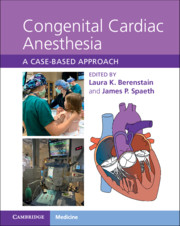Book contents
- Congenital Cardiac Anesthesia
- Congenital Cardiac Anesthesia
- Copyright page
- Dedication
- Contents
- Contributors
- Introduction
- Chapter 1 A Congenital Heart Disease Primer
- Section 1 Left-to-Right Shunts
- Section 2 Right-Sided Obstructive Lesions
- Chapter 6 Critical Pulmonic Stenosis
- Chapter 7 Tetralogy of Fallot
- Chapter 8 Repaired Tetralogy of Fallot
- Chapter 9 Tetralogy of Fallot with Absent Pulmonary Valve Syndrome
- Chapter 10 Tetralogy of Fallot, Pulmonary Atresia, and Aortopulmonary Collaterals
- Chapter 11 Pentalogy of Cantrell
- Chapter 12 Ebstein Anomaly
- Chapter 13 Ebstein Anomaly, Palliated
- Section 3 Left-Sided Obstructive Lesions
- Section 4 Complex Mixing Lesions
- Section 5 Single-Ventricle Physiology
- Section 6 Heart Failure, Mechanical Circulatory Support, and Transplantation
- Section 7 Miscellaneous Lesions and Syndromes
- Index
- References
Chapter 9 - Tetralogy of Fallot with Absent Pulmonary Valve Syndrome
from Section 2 - Right-Sided Obstructive Lesions
Published online by Cambridge University Press: 09 September 2021
- Congenital Cardiac Anesthesia
- Congenital Cardiac Anesthesia
- Copyright page
- Dedication
- Contents
- Contributors
- Introduction
- Chapter 1 A Congenital Heart Disease Primer
- Section 1 Left-to-Right Shunts
- Section 2 Right-Sided Obstructive Lesions
- Chapter 6 Critical Pulmonic Stenosis
- Chapter 7 Tetralogy of Fallot
- Chapter 8 Repaired Tetralogy of Fallot
- Chapter 9 Tetralogy of Fallot with Absent Pulmonary Valve Syndrome
- Chapter 10 Tetralogy of Fallot, Pulmonary Atresia, and Aortopulmonary Collaterals
- Chapter 11 Pentalogy of Cantrell
- Chapter 12 Ebstein Anomaly
- Chapter 13 Ebstein Anomaly, Palliated
- Section 3 Left-Sided Obstructive Lesions
- Section 4 Complex Mixing Lesions
- Section 5 Single-Ventricle Physiology
- Section 6 Heart Failure, Mechanical Circulatory Support, and Transplantation
- Section 7 Miscellaneous Lesions and Syndromes
- Index
- References
Summary
Similar to other variants of tetralogy of Fallot (TOF), TOF with absent pulmonary valve syndrome includes an anterior maligned ventricular septal defect, an aorta that “overrides” the septal defect, and a hypertrophied right ventricle. However, it is distinct in that there is an absent or rudimentary, incompetent pulmonary valve. The pulmonary valve, if present, may have some degree of stenosis but the dominant pathophysiology is pulmonary regurgitation. Patients usually have unobstructed flow to the pulmonary arteries and therefore do not have cyanosis or hypercyanotic spells associated with other tetralogy variants. The main and branch pulmonary arteries are generally dilated due to pulmonary regurgitation and excessive flow and can be large enough to cause a mass effect on surrounding structures, including the airways and lungs. Patients with unrepaired tetralogy with absent pulmonary valve syndrome have respiratory symptoms and cyanosis related to the degree of intracardiac shunting and airway compression. This chapter addresses the perioperative cardiorespiratory challenges of caring for an infant with this syndrome.
Keywords
- Type
- Chapter
- Information
- Congenital Cardiac AnesthesiaA Case-based Approach, pp. 52 - 56Publisher: Cambridge University PressPrint publication year: 2021

